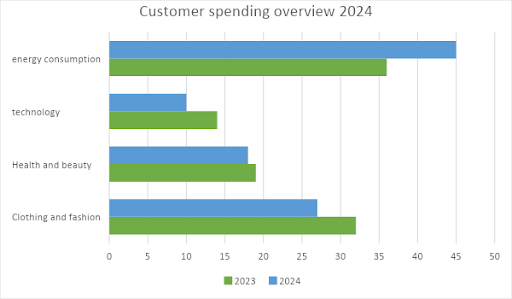Inflation continues to be the prime reason for the deviating sales volume. Consumers reduced the number of purchases in the wake of rising costs. The conscious spending may continue even in 2024. It makes the fashion industry market look subtle in the first half of 2024.
However, 2024 still looks better on the growth side. According to the annual consumer sentiment survey, “96% of customers prioritise stable living compared to 98% last year. The whopping interest rates in 2023 are the reason behind the change.
The chart below represents how spending may change in 2024.
Apart from these categories, customers may invest more in dining out and takeaways. Alternatively, investment in clothing has decreased from 32% to 27% in 2024 due to inflation blows.
However, according to the Bank of England, the inflation rate may stay at 2% from May 2024. Interest rates may fall making purchases affordable for individuals. It may prove positive as around 70% of customers wish to resort to the existing beauty brand after the inflation eases.
What sells the most in the beauty and fashion industry in 2024?
“Hair growth supplements” is the most searched phrase in the beauty industry. It reveals a 100% increase in searches in comparison to 2023. In the following vein, “biotin supplements” are searched 75% more than in previous years. Individuals reveal more concern about ensuring healthy hair and embracing treatments. Moreover, the trend does not seem to lose customers anytime soon.

Which demographic group spends the most on fashion?
Gen Z spends about 75% of their income on clothes in comparison to 65% of millennials.
According to fashionnetwork.com, “Gen Z spend £242 over the first half of 2024. Additionally, they outstand other generations by a quarter (£187.71). This totals around 700 million expenditure figures by Gen Z alone.

How much should you spend each month on Clothing?
According to a popular financial planner, “an individual should spend 5% of their income on Clothing. For example, if you earn £25000 or £23700 after taxes. You must spend £65 (25000-23700/100) on clothing needs per month. Alternatively, individuals with higher salaries have more budget flexibility. Check the bar below to understand how much you should spend on Clothing per month:
| Annual salary (in pounds) | Annual Take home Pay (in pounds) | Monthly clothing budget (in pounds) |
| 16000 | 14416 | 60 |
| 40000 | 30736 | 128 |
| 75000 | 52036 | 217 |
| 100000 | 66535 | 277 |
Which parameters make the UK the pinnacle of the fashion industry in 2024?
The UK never hesitates to make a fashion statement from footwear to apparel. Moreover, it was the prime wool exporter in the early ages. Additionally, with constant contributions to styles, designs and employment, the Fashion industry is worth more than any country.
As of 2024, “the UK fashion industry is worth £26000million, making it the largest in the world.” Under this, “textile and fashion exports contribute 6.5 billion to the worth.
Other facts that make the UK the pinnacle of the fashion industry:
- Generates maximum employment
UK fashion brands are known for their classic twists and innovative styles. Additionally, “Pure London” is a popular UK fashion event showcasing the best products from mid-high ranges.
Moreover, the industry is continuously growing and provides employment opportunities for the aspirants.
According to Allianceexperts statistics, “The UK fashion industry provided about 797,000 employments”, according to the research by Oxford University.
- Leader in Fashion Education
The UK is the world’s leading country in fashion Education. It hosts 20 popular fashion universities. Among these, Loughborough University is the most popular one. About 5000 students enrol for British fashion courses every year.
This surpasses the institutional admission counts in China and East Asia. The institution must leverage the opportunity by re-analysing the fashion curriculum according to present-day needs.
Constant research, surveys, and advanced technology are required to make fashion accessible to all. However, most fashion businesses refrain from transitioning due to budget constraints. Here, financial experts like a Business loan Broker help you finance it hassle-free. The broker helps you from spotting the best private lender to loan approval. Find one online by highlighting the budget, finances and other parameters. It is the fastest and most affordable way to finance the institutional requirements.
- Host the popular “London Fashion Week” show
London Fashion Week will celebrate its 40th anniversary in 2024. The show prioritises environmental awareness in the wake of fashion waste. The focus is to ensure a sustainable fashion with re-purposed waste textile materials.
Around 77% of Europe shoppers reveal interest in buying sustainable products. Furthermore, 51% of them are willing to pay more.
- High revenue women’s apparel market
According to Statista reports, “the UK retail market may reach 75 million pounds by 2026.” Here, the women’s apparel market segment crosses-44.6 billion GBP (£).” It is far higher than the men’s and children’s segments.
The best ways to boost revenue on women’s clothing is by:
- Using AI to fix size issues
- Ensure an innovative marketing and return policy
- Avoid delayed customer responses
- Ensure an SSL on your website to generate authenticity
- Improve personal shopping experience by industry and launching more sizes and varieties
Adopting a massive change is challenging for any business. Moreover, if it means launching a new range, the expenses increase. Dedicate 35% of cash reserve to optimising product development and survey process. It would not impact the operations much. However, options like working capital loans may help optimise other business operations like- replacing furniture, hiring, and or releasing payments.
- 3d Printing and AI technology
3D printing technologies are here to create the best personalisation, sustainable and creative customer experience. Many brands are embracing 3D technology from footwear collections to the best tees. Popular brands like Nike, Zara, and H&M, use AI in their business model.
Bottom line
The UK fashion industry is growing rapidly amid the existing economic scenario. Customers prefer sustainable and affordable fashion amid the economic uncertainties. Businesses operating in the fashion niche must align their practices with recent trends and customer behaviour. It is the sure-fire route to success.

Harry Kane is a financial writer and author who has covered wide topics related to business loans and finance for the last decade. He has been working as the Chief Contributor in finding out deals on various business finance products covered by Thebusinessfunds, a reputed business loan broker firm in the UK. The primary work of Harry is to analyse the loan requirements of various businesses according to their circumstances and affordability. He directly communicates with the loan aspirants and guides them to get the right loan matching their needs. He has a vast experience in finance writing, working with many major business firms in the UK. At Thebusinessfunds, Harry also used to write well-researched blogs covering the financial problems of business loan aspirants and providing relevant solutions. He is a postgraduate with MSc. in Banking and Finance.






